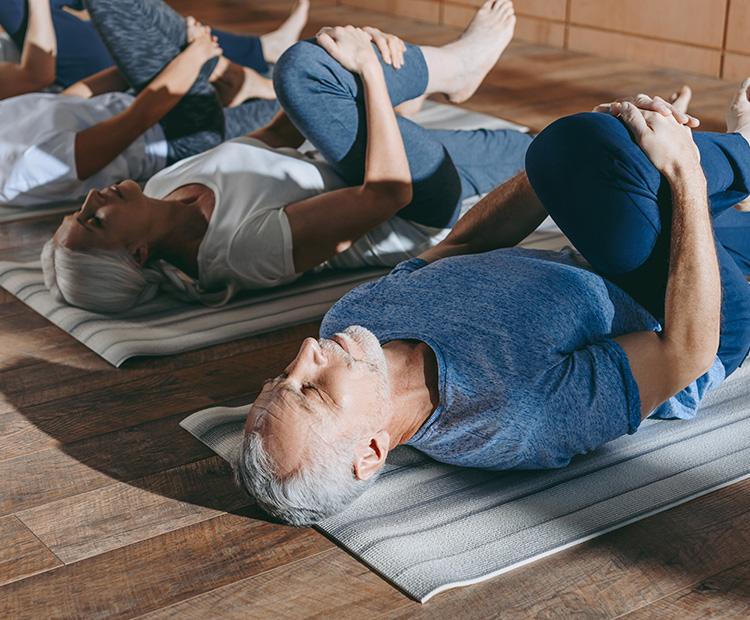Spinal stenosis is the narrowing of the spinal canal, which puts pressure on spinal nerves and causes chronic back pain that can disrupt daily life.
Common in adults over 50, this condition is often linked to arthritis but can also result from spinal injuries or, in rare cases, a naturally small spinal canal (congenital stenosis).
Low back pain caused by lumbar spinal stenosis may be treated with various options, including exercises to improve strength and flexibility.
With the guidance of a healthcare professional, exercising safely can be an essential part of a plan to treat spinal stenosis. This article will explore how exercise can help spinal stenosis, the best exercises to try, and some of the other treatment options that may be recommended.
How Can Exercise Help Spinal Stenosis?
Although regular exercise can help improve spinal stenosis symptoms, it cannot make spinal stenosis go away. However, in some cases, the benefits of spinal stenosis exercises may be as effective as surgery1.
Why does exercise help spinal stenosis? Many people with back pain worry that exercise might make it worse. However, the right exercises can gently improve strength and flexibility, reducing spinal stenosis symptoms and making movement easier. Increased blood flow from exercise can also help relieve pain.
What Exercises Should Be Avoided with Spinal Stenosis?
Although exercise can help improve spinal stenosis, some exercises can do more harm than good. Avoiding these types of exercise is crucial to help reduce spinal stenosis symptoms:
- High-impact exercise, including running, jumping, and contact sports like football
- Repetitive motion
- Heavy lifting with a rounded back, which places strain on spinal discs
- Exercises that hyperextend the back (including some yoga poses)
- Long walks
What Are the Best Exercises for Spinal Stenosis?
Several exercises can help improve spinal stenosis symptoms. It is important to always consult with a healthcare professional before beginning any exercise routine.
Exercises to Improve Strength
Strengthening your core can support the spine. These exercises target key core muscles:
1. Plank exercises
Several plank exercise variations can be used for those with spinal stenosis. These can include standard planks raised on the elbows with the body parallel to the floor and held for several seconds, as well as side planks.
2. Pelvic tilts
There are a couple of ways these can be done:
- Supine (lying) pelvic tilts involve lying on the floor with knees bent. The back is pressed into the floor by tilting the pelvis upward, and then the pelvis returns to a neutral position.
- Pelvic tilts with an exercise ball involve sitting on the ball with feet hip-width apart. Inhale and engage the core, then exhale while tucking the tailbone. Inhale again to return to a neutral position.
3. Knee hugs
From a seated starting position, draw the knee to the chest and hold for several seconds. Release the hold and repeat with the opposite knee.
4. Lumbar flexion exercises
Similar to pelvic tilts, these exercises can be performed by lying on the floor and gently rounding the lower (lumbar) spine upward, relieving tension in the lower back. These will also strengthen lumbar muscles to reduce symptoms of lumbar spinal stenosis.

Exercises to Improve Flexibility
Stretching improves spinal mobility, increases range of motion, and reduces pain. These exercises help build flexibility:
1. Hip flexor stretches
Step one foot forward into a lunge and lower the back knee. From here, gently push the hips forward to stretch the front of the hip while keeping the torso upright.
2. Knee-to-chest stretches
Lie flat on the floor and slowly draw one knee (or both knees) to the chest. Hold the position for several seconds.
3. Hamstring stretch
Similar to knee-to-chest stretches, this stretch starts by lying flat on the floor. Draw one leg up towards the body and slowly extend it upwards. Repeat on the other side.

Functional Exercises for Daily Activities
Exercises that support everyday activities can be especially helpful for spinal stenosis. Targeting movements used in daily activities improves strength and flexibility.
1. Sit-to-stand exercises
From a starting position seated in a chair, stand up fully and slowly lower back down to a seated position. Repeat the movement to improve lower body strength and stability.
2. Standing-forward bend
With legs hip-width apart, slowly lean forward with arms dangling toward the feet. Slightly bend the knees, then slowly return to an upright position.
3. Wall squats
This squat makes use of walls for additional support. Stand with the back against a wall, feet shoulder-width apart. Slowly slide down into a squat and hold the position.

What Are Some Other Treatments for Spinal Stenosis?
Along with exercising, a professional like a board-certified pain specialist can help guide decisions about other successful treatment options for spinal stenosis symptoms. Common options include:
- Physical therapy— a physical therapist can also help guide exercises performed at home
- Facet joint injections— a non-operative treatment to reduce pain and inflammation in the joints of the spinal column
- Epidural steroid injections— another non-invasive option that reduces inflammation at the spinal nerves with a corticosteroid
- Pain medication
- Surgery
At Advanced Spine and Pain, our team can review each case to develop the best treatment plan, including a personalized exercise plan to support strength and flexibility and reduce symptoms of spinal stenosis. Get started today by contacting us online or calling 480-573-0130.
References
1. Mo Z, Zhang R, Chang M, Tang S. Exercise therapy versus surgery for lumbar spinal stenosis: A systematic review and meta-analysis. Pak J Med Sci. 2018 Jul-Aug;34(4):879-885. doi: 10.12669/pjms.344.14349. PMID: 30190746; PMCID: PMC6115590.

